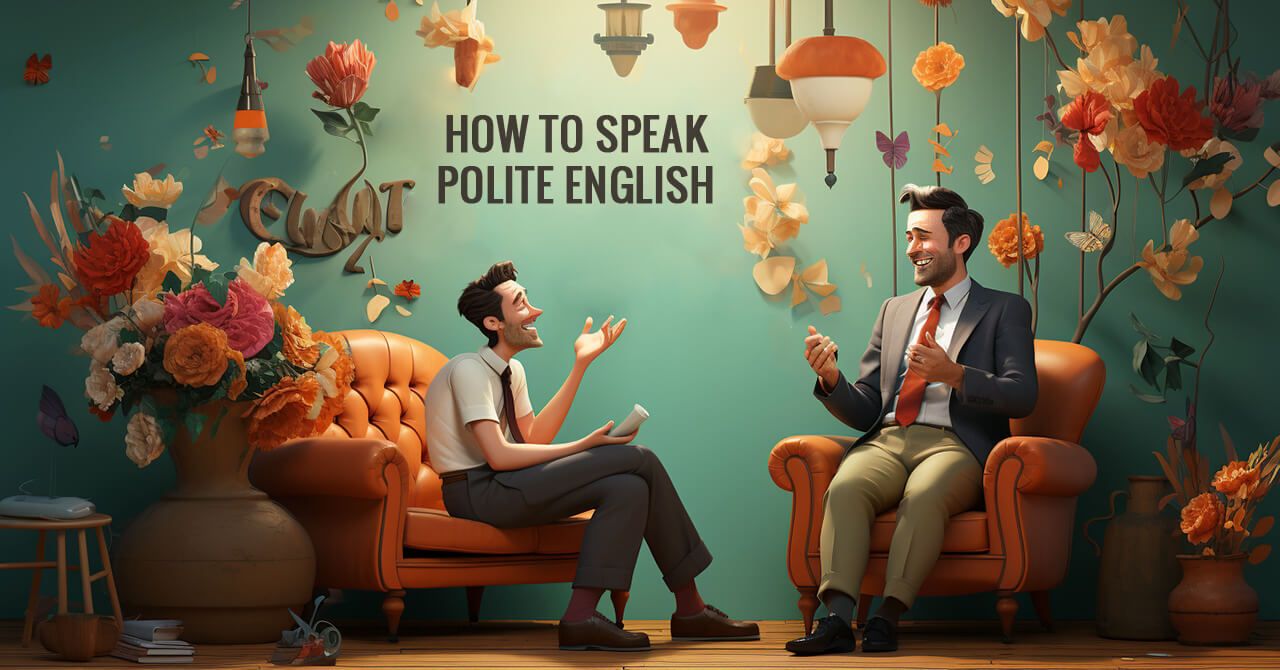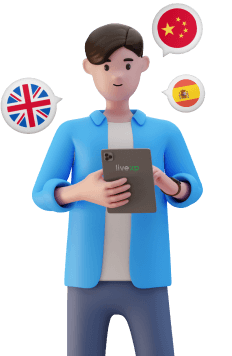
A Simple Guide to How to Speak Polite English
Politeness in English is not a one-size-fits-all concept. It changes based on where you are and who you’re talking to.

Get a FREE guide!
Want to sound like a native English speaker?
Get our free PDF with top tips that work.

Check your email!
There’s more to politeness than just saying “please” and “thank you.” There are a lot more polite phrases and expressions, of course, but knowing exactly when to use them is just as important as knowing all the words by heart.
Politeness depends on the context
A perfectly polite phrase that works fine in a formal setting or one that belongs to court etiquette can make you look funny and even weird if you are at a beach or attending an informal party. It goes the other way around, too. For example, “thanks bro” can be an articulation of heartfelt gratitude among friends, but if you say that at a business meeting, on a job interview, or on any formal occasion you can think of, you will certainly come across as rude, impolite, and even uneducated.
Let’s see some more examples. The following phrases are undoubtedly polite, but that doesn’t mean you should use them as much as you can.
I would be most obliged if you could extend your assistance.
I hereby request your presence at the dining table.
May I have the honor of partaking in a beverage with you?
I humbly beseech you to consider my proposal.
Would you be so kind as to pass the condiments?
I express my utmost gratitude for your companionship.
Saying any of these when you’re hanging out with friends would make them chuckle, but someone might see it as an example of your sense of humor. Using them with strangers would make you look weird, regardless of the setting—except if you get access to a time machine and find yourself in another era, dining with aristocrats. Actually, you should probably never use any of these expressions at all.
Now, let’s see another set of polite phrases that may leave a wrong impression.
You’re the best! Thanks a ton!
No worries, buddy, I’ve got your back.
Hey, you nailed it! Awesome job!
Let’s grab a bite, my treat!
Wow, that’s a bummer. Let me know how I can help, alright?
All of these sentences are great for informal situations with friends and family. They communicate heartfelt gratitude, support, appreciation, willingness to pay for a meal, and sympathy for someone’s loss—but only in certain contexts. Say any of those to a person you don’t know well or to just about anyone in formal situations, and the effect will be horrible.
Politeness in English is not a one-size-fits-all concept. It changes based on where you are and who you’re talking to. The way you speak in a business meeting will differ from how you chat with friends at a café. Additionally, what’s considered polite in the United States might be different in the United Kingdom or Australia (we’ll see some examples later). Understanding these variations is key.
Levels of formality and levels of politeness in English
We’ve seen some extreme examples of formal and informal polite expressions. However, there are more than two levels of formality in English. It is much more complicated.
Academic disciplines such as sociolinguistics and stylistics examine how language style or tone changes based on what’s appropriate for the social setting. This includes factors like the situation, whether it’s public or private, the nature of communication, how many people are involved, and the relationship between the speakers (mostly how well they know each other). An American linguist named Martin Joos wrote about five levels of formality in language, ranging from intimate to frozen. These are intimate, casual, consultative, formal, and frozen.
Frozen communication sounds funny, but this term describes a real thing. It refers to static, extremely formal ceremonial language and wording used in safety briefings and similar contexts. When it comes to politeness, these situations require a fixed set of phrases that you either know or you don’t.
In communication theory, how formal or informal we are is a key part of how we talk to different people. Edward T. Hall outlined different “zones” that affect our communication, from intimate to public. These are intimate, personal, social, and public (or impersonal).
These distinctions may seem a bit obsolete today. We live in a world of social media where casual and even intimate ways of communication seem to be acceptable in the public sphere. In a way, the levels of formality are mixed up, and sometimes it’s tricky to identify them. But the overall principle is the same.
When we choose how to communicate, our communication style and level of politeness need to reflect two things: the type of relationship we have with the recipient and a common-sense judgment on whether a particular style is suitable for the situation.
In short, let’s just say that English still has different levels of formality, and each has its own set of polite phrases. In formal situations, phrases like “Would you be so kind as to…” or “I would greatly appreciate if…” are appropriate. In semi-formal contexts, you might say, “Could you please…” or “I’m wondering if…” In informal settings with friends or family, a simple “Can you…” or “Could you…” works well. I’ve included a list of such phrases in the last section of this article.
The bottom line when it comes to the levels of formality is the importance of matching your language to the situation to avoid coming across as too stiff or too casual. To do so, you need to read personal and social cues.
Practice polite English with LiveXP
To truly master polite English, taking private lessons with an English teacher can make a significant difference. On LiveXP, you can find exactly this type of focused learning. The beauty of one-on-one lessons lies in having the teacher’s complete attention, which naturally leads to a more personalized and effective learning experience. The platform also offers great flexibility, allowing you to schedule lessons at your convenience and even change plans if something comes up.
What sets LiveXP apart is the chance to learn from teachers from different corners of the globe. This variety isn’t just about hearing different accents; it’s about understanding the nuances of politeness in various cultural settings. If you’re the type who enjoys learning from different perspectives, LiveXP lets you work with several tutors under just one subscription. Plus, the Word Trainer feature can help you memorize polite expressions easily with a spaced repetition method.
How to take cues from the other person
Paying attention to how the other person speaks and acts can guide you on how to respond. This involves listening to their choice of words, tone and observing their body language. For example, if someone speaks to you in a very formal manner, it’s polite to respond similarly. On the other hand, if they are more relaxed and use casual language, you can feel free to do the same while still being respectful. This adaptability shows respect for the other person’s communication style.
The ability to take cues is related to emotional intelligence and listening skills as much as to the knowledge of conventions of a particular way of communication. After all, politeness is a matter of behavior and not just language.
Ultimately, to be polite in any situation, initially, you need to put an emphasis on others instead of what you want to say. Listen to others closely, both the core message and the communication style. Pay attention to every detail about the person you’re talking to and the entire context. Restrain the need to speak about yourself, your opinions, attitudes, and feelings until you’ve got enough cues and determined the safe way to proceed.
Of course, some situations, such as job interviews and interviews in general, require talking about yourself straight away, and you need to be prepared for them in advance. In other situations, though, you don’t need to speak much at all. Most often, forcing your topics and interests can be seen as inappropriate and even rude. In such situations, if you hold back your need to speak and just listen for a while, you’ll get the exact measure and be able to leave an impression of a truly polite person.
Now, for this guide to be really useful, let’s see what it means to speak politely in different contexts.
How to speak politely at work
In the workplace, politeness is crucial. That’s why you can often hear advice such as—start every email with a friendly greeting and finish with a courteous closing, like “Kind regards” or “Best wishes.” During meetings, listen attentively and wait for your turn to speak. If you disagree with someone, express it respectfully, using phrases like “I see your point, but I think…” or “Perhaps we could also consider…”.
These and similar tips are useful, but they don’t cover everything. The world has changed quite a bit during the last few decades, and business surroundings are not as they used to be. There are still some old-school companies that use the conventional etiquette, but there are also lots of new ones with thoroughly different company cultures. And when we consider the dissimilarities between business communication in different cultures, we’ve got quite a mix.
If you’re a CEO or an HR who feels that your company has business communication barriers, LiveXP corporate language training can help your employees practice English and overcome these barriers. LiveXP B2B program is full of flexibility and features for companies.
I’ve had the opportunity to work with clients from all continents, and their communication styles differ tremendously. My tactic when starting communication with someone who belongs to a culture I don’t know well (and any new client, for that matter) is to take cues from any source I have, including the job ad content, the wording in the invitation to interview, and the first message I get from them.
How to be polite among friends and avoid being rude by being polite
With friends, you can relax a bit more, but respect is still important. It’s fine to use slang and make jokes as long as everyone is comfortable. Be aware of your friends’ boundaries and avoid topics or words that might upset them. Being casual doesn’t mean being careless with your words.
Sometimes, what we think is friendly small talk can be seen as rude. To avoid this, steer clear of personal topics like age, income, marital status, or political opinions unless the other person brings them up first. If you realize you’ve said something inappropriate, apologize.
Useful polite phrases and expressions in English
Here’s a list of helpful phrases for different situations.
Formal situations (e.g., business meetings, professional emails)
“Would you be so kind as to…”—A polite way to ask for a favor.
“I would greatly appreciate if…”—Expressing gratitude in advance for an action.
“I’m pleased to meet you.”—A formal greeting in a first-time meeting.
“Thank you for your consideration.”—Showing appreciation for someone’s attention or thoughtfulness.
Semi-formal contexts (e.g., workplace gatherings, acquaintances)
“Could you please…”—A polite request that is not too formal.
“I’m wondering if…”—A softer way to ask a question or make a request.
“I believe we haven’t met before. I’m [Your Name].”—Introducing yourself in a friendly yet semi-formal manner.
“Thank you for your help.”—Expressing gratitude in a professional yet friendly tone.
Informal settings (e.g., with friends, family)
“Can you…” or “Could you…”—Casual ways to ask for something.
“I really appreciate…”—Informal way to express gratitude.
“Hey, how’s it going?”—A casual greeting among friends.
“No worries.”—Informal way of saying that everything is fine or to dismiss apologies.
Interacting with strangers (e.g., public transport, stores)
“Please”—Always useful for polite requests.
“Thank you”—To express gratitude in any situation.
“Excuse me”—To get someone’s attention politely or to apologize for a minor inconvenience.
“Sorry to bother you, but…”—A polite way to initiate a request or ask a question.
Apologizing
“I’m sorry, I didn’t mean to…”—Apologizing for an unintended action or misunderstanding.
“I apologize if I came across as…”—Expressing regret for possibly being misinterpreted.
“It was not my intention to…”—Clarifying that any hurt caused was unintentional.
These expressions are polite and appropriate for the given context. You can use them in this shape or adapt them to the message you want to get across, but first of all, assess the context and get some useful cues.
















